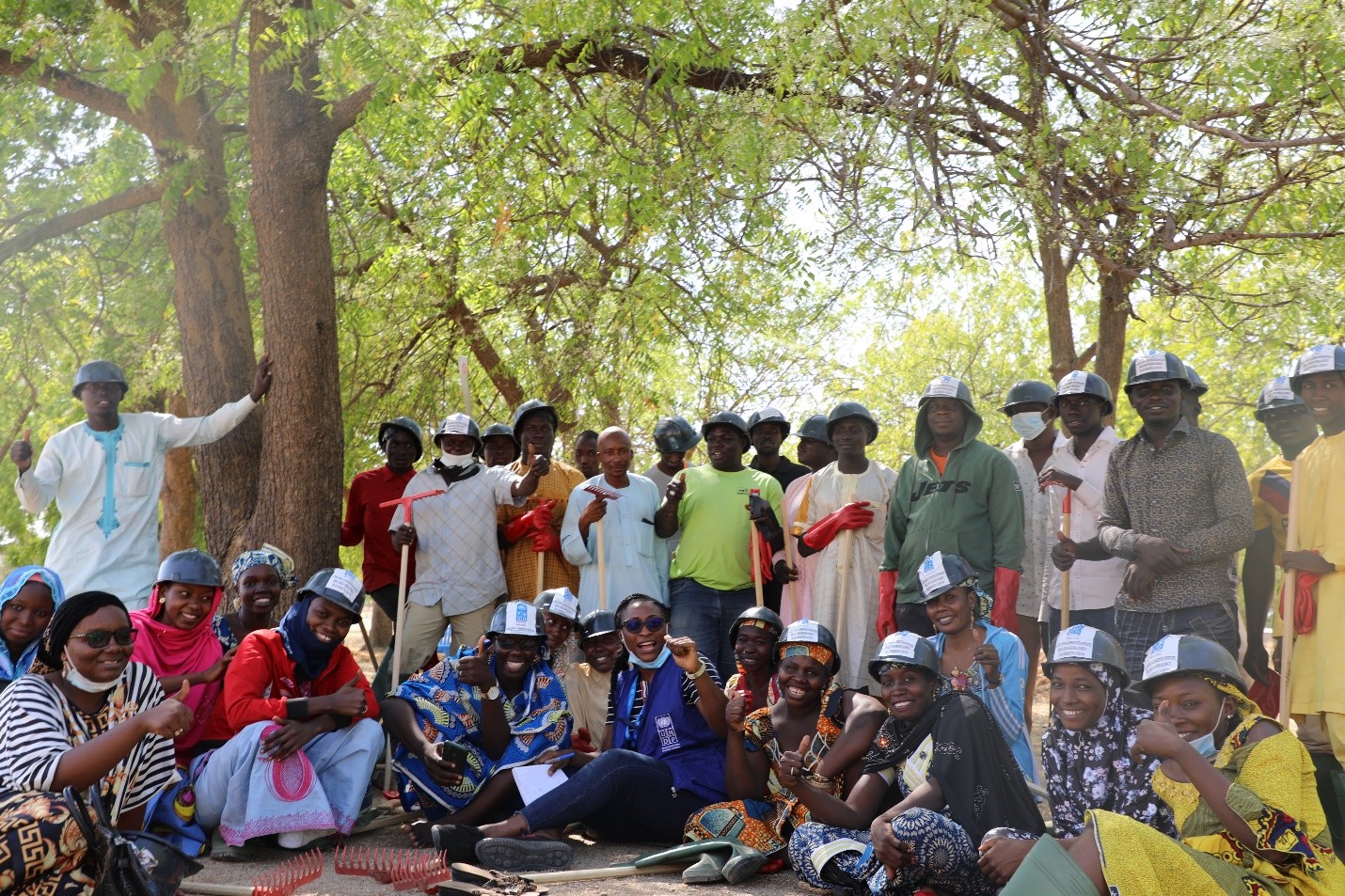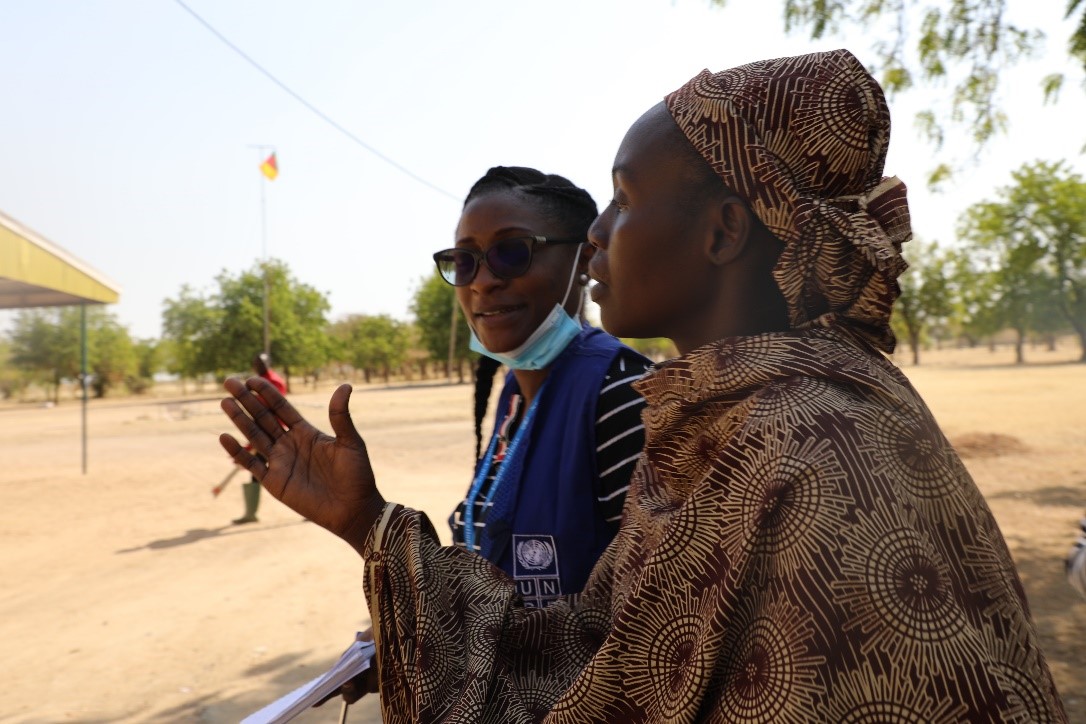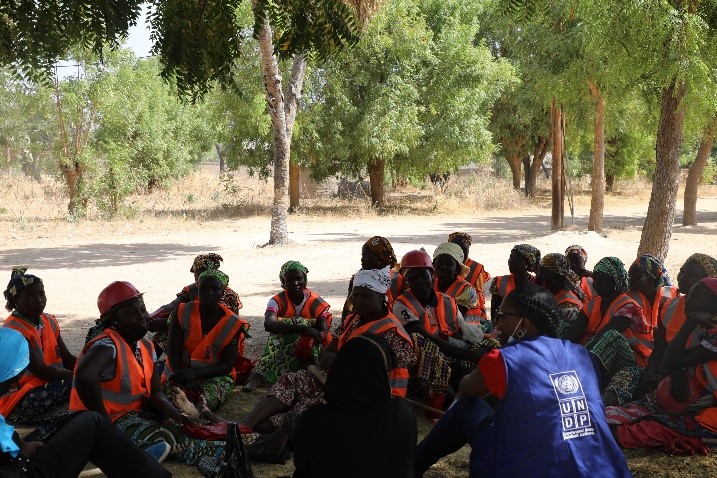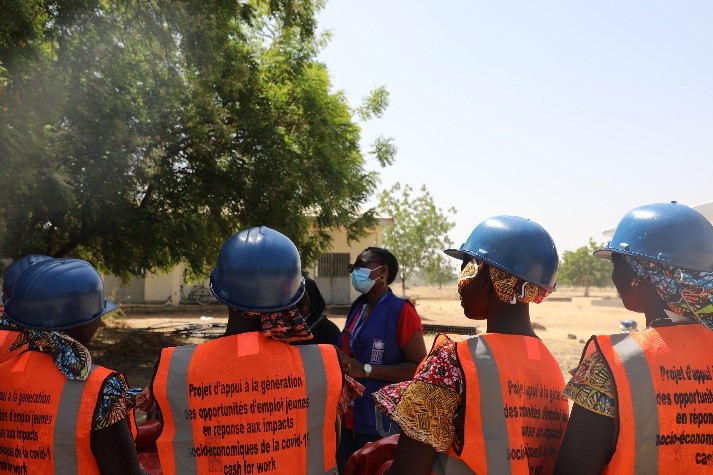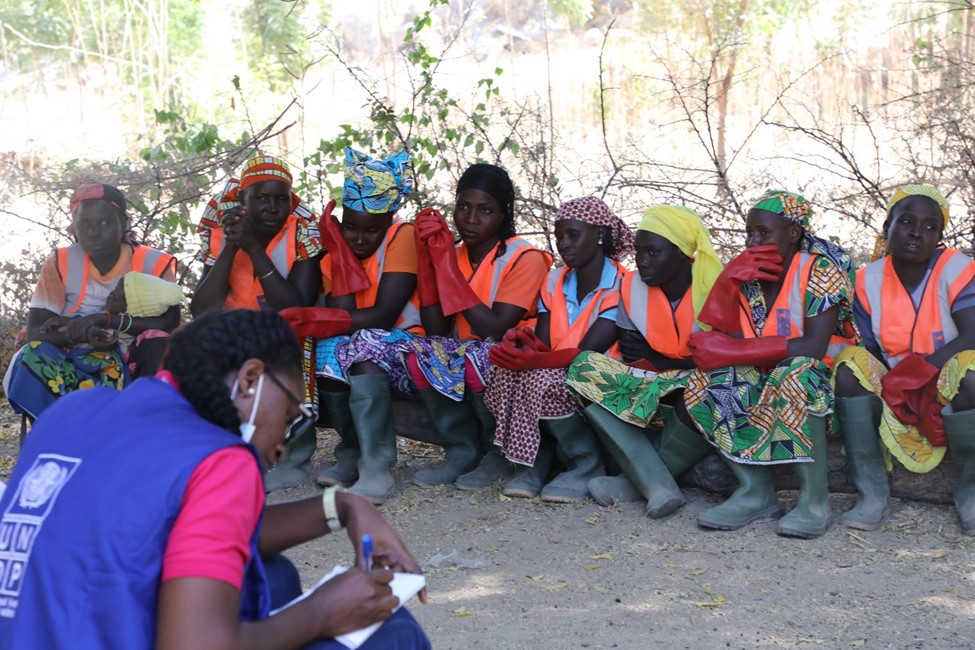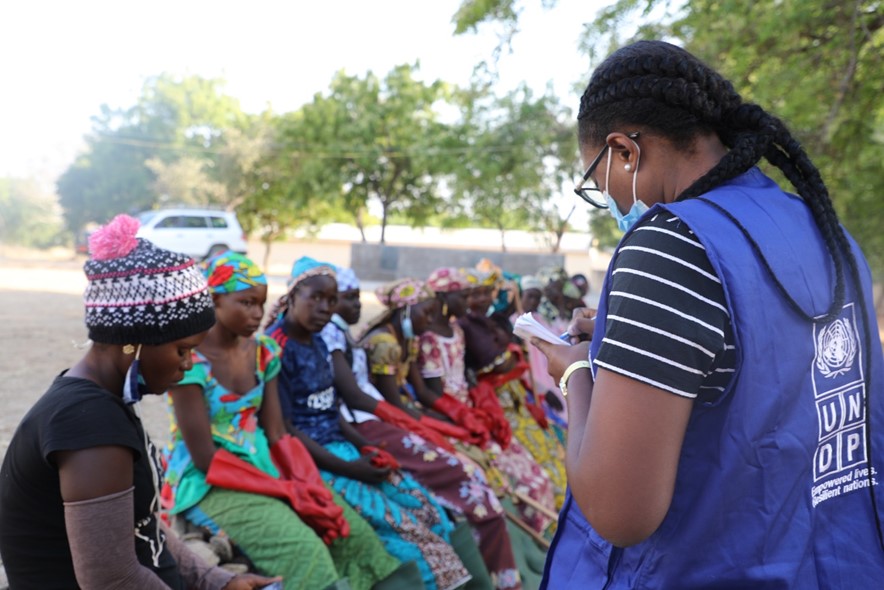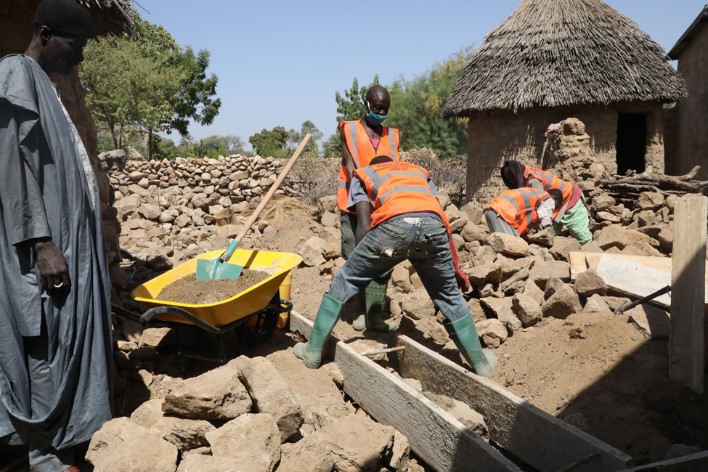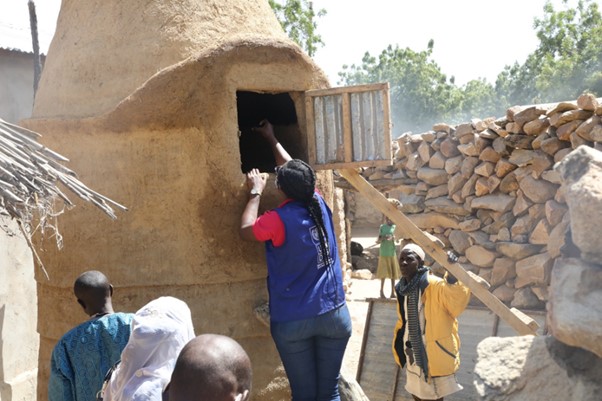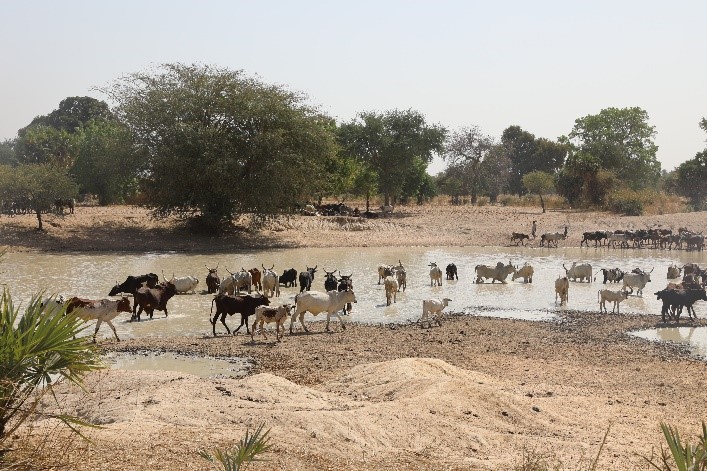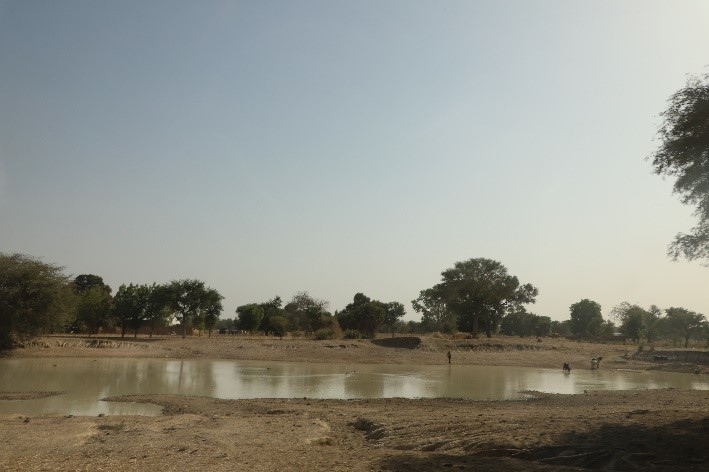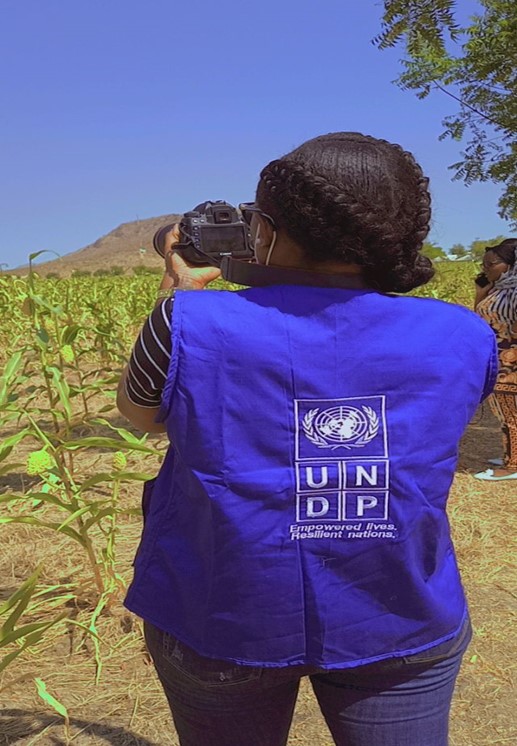By Anna Ojong, Head of Solutions Mapping, UNDP Cameroon
Once upon a time, a Solutions Mapper participated in a COVID-19 support mission to mitigate the impact of Covid-19 pandemic on youth and women in ten communities of the Far-North region of Cameroon. The mission was part of the UNDP Cameroon Country office’s response initiative to address increased vulnerability brought about by the COVID-19 pandemic on local populations’ livelihood and income. The project called “Cash for Work”, aimed to bring simple solutions to mitigate the socio-economic impact of COVID on 500 youth and Women, who have been affected by the pandemic in terms of jobs losses in these communities.
Launch of Cash for Work Activities in Gazawa, Photo Credit: Ibrahim Djagra, UNDP
Taking part in such a mission was such a great idea for the new Accelerator Lab team! It was an opportunity to explore further to understand the emerging challenges and opportunities surrounding youth employment in rural communities. An opportunity to identify typical grassroot solutions to challenges of youth employment and entrepreneurship, our first frontier challenge, just so you know!
I was excited, well prepared with a questionnaire that I thought would trigger insightful responses from the participants of the different focus group discussions the lab aimed to have on the perceptions and perspectives of this assistance from UNDP. Before the mission, I thought the issues raised in the questionnaire would be the main concerns of the local youths and women; in fact, I had a preconceived idea of what their challenges might be. Albeit, that wasn’t the case when we got to the field and started talking to these people.
"Interesting to note, my concerns on youth employment and excitement to identify local solutions that address unemployment was the least of priorities raised by men and women in these communities".
A number of challenges were mentioned that varied between men and women, ranging from COVID-19, climate change and environmental factors impacting on agriculture and food security, education, infrastructure, ,non-scalarization of the girl child, gender inequality, insecurity, and health care concerns!
The insecurities affecting the far-north region of Cameroon since 2014 with the onset of the Boko Haram attacks has deprived some of the most vulnerable groups from development opportunities, led to unequal distribution of resources and increased inequalities between men and women. Existing harsh and extreme climatic conditions impacting on agriculture and livestock which are a principal activity in the region has not made things easier for the local population as well. In these difficult climatic conditions, the capacities to transform and store food to be used in moments of scarcity have remained low despite the flourishing market gardening activity in the region.
Above all, gender inequalities characterized by increased unpaid labor for women, absence of services capable of responding to their specific needs and capacities, discriminatory social norms impacting the economic growth of women and girls all continue to prevent them from utilizing their full potential.
Then the COVID-19 pandemic and its impact on the livelihood and income of men and women. Barrier and preventive measures characterized by border closures has continued to impact businesses and the flow of cash for men and women in these communities.
Talking to these local groups, their only request for comfort, stability and growth was “Means” …they said!
« We need means and opportunities but COVID 19 has made things much difficult!» they said.
It was hard to go further without wanting to know more on the challenges these different groups encountered. Opportunities for escaping these challenges mentioned were a thin line between the realities of the region in terms of insecurity, climate change, environmental, socio-cultural factors and the current COVID-19 challenges.
At some point, going further to address the prepared questionnaire became difficult as feelings of empathy towards their challenging stories set in. Instead of intended insights on the preference for monthly salary job types or income generating activities, their difficulties in accessing gainful employment, communication on employment opportunities, their needs for gaining decent employment, just to name a few, the stories from the different ethnic groups, quite similar for all the communities made me think otherwise with much focus on gaining more insights on the challenges they raised
The realities observed for the different groups did not facilitate my understanding on how I was supposed to stay focused on identifying solutions that work and which do not, in order to better mitigate the impact of COVID on employment opportunities for youth and women. Obviously not a homogenous group of persons, coupled with educational levels ranging from very low, low, medium, high, and very high.
However, the women of the Toupouri and Podoko ethnic groups in these communities shared very intriguing realities. Stories which revealed the need to restrategize development interventions at country office level, while laying more emphasis on the consideration of gender perspectives in UNDP’s work.
Discussions within these communities incorporated an ethnographic and gender sensitive approach. Separate group discussions were organized for men and women, including key informant interviews. Besides the need to capture firsthand and uninfluenced facts, it was an opportunity to understand what other domains the country office could focus its attention and strengthen its interventions when addressing development challenges such as youth unemployment.
Key Interview with Youth Delegate of Gazawa, Photo Credit: Ibrahim Djagra, UNDP
Then came this quick instinct to understand the interplay between socio-cultural norms, COVID-19, and improved living standards in these communities after having an in-depth discussion with the female beneficiaries of this project. The “Cash for Work” intervention targeted 50% of women in each of these communities and listening to their stories was an eye-opening experience. Rethinking new development and investment opportunities for the Country office made more meaning as insights on integrating gender and women empowerment in development programmes were captured. This was equally an opportunity to think about unusual development actors for partnership with Country office, while addressing issues of unemployment in a COVID-19 context greatly affected by gender stereotypes and socio-cultural norms. Improving employability for youth and women in these communities through simple solutions that could bridge the gender gaps became a point of focus. The Cash for Work project intended to build back better from COVID with a goal of preventing vulnerable groups from joining radical extremist groups. Providing support to the country office for the realization of this goal could not be effective without understanding existing community challenges and opportunities. Certainly, there was another entry point to addressing decent work and economic growth! Understanding the inequalities between men and women and knowing how to address socio-economic growth of men and women from an inequality standpoint approach, rather than just COVID and Conflict, which by the way have only stimulated existing disparities in these communities.
Evidences of a root cause to a problem initially identified were glaring and it was time to divert and get focused on what could be described as a “an intestinal parasite” for these communities, preventing the growth and development of specific groups.
Focused Group Discussions with women of Tchatibali. Photo Credit: Ibrahim Djagra, UNDP
Focused Group Discussions with women of Datcheka. Photo Credit: Ibrahim Djagra, UNDP
To most of these women, the cash for work activity was considered timely, “À point nommé!” as they exclaimed in the French language. It was a big relief not just to the socio-economic challenges posed by COVID-19, but most especially to the challenges posed by socio-cultural norms that have long been the modus operandi of these communities.
Community Realities faced by the Toupouri and Podoko Women
“We are not given an opportunity to exchange words with our spouses says Panta Kouma on behalf of the other women with whom she shares the same culture. From childhood we are made to understand this, and nothing can change. Even just responding to a man (spouse) who has wronged you is considered disrespectful” she added.
Focused group discussions with women of Makoulahe, Photo Credit: Ibrahim Djagra, UNDP
“The husbands here get us pregnant and disappear for even up to 2, 3, 5 and even 10 years before resurfacing”. During this time of their absence, these women are hardly ever informed of the whereabouts of their spouse. Some of these women while talking testified to have been victims and it was considered a common practice, while the burden of childcare remained her sole responsibility as they continued to struggle with their usual small businesses for survival.
High birthrates, little or no income to manage these hardships, no access to health care services, the absence of women empowerment centers and even a low knowledge of their sexual and reproductive health rights were realities of women belonging to these ethnic groups. Coupled with different forms of violence infringed on them by men who treat them like objects. According to these women, the girl child was a perfect replacement and sacrifice for more children in a household. When space in the house became small to accommodate everyone, the girl child had to give way, they said funnily while laughing. In communities where houses are usually characterized by very small hurts built with mud bricks and grass roof tops, liberating space meant the future of the girl child was at risk, forced marriages and her education which in these communities has never been prioritized like that of the male child!
Thus, there is definitely very limited opportunity for women to find decent employment opportunities in these communities as their childhood is constrained by the society in which they find themselves.
Discussions with female Beneficiaries in Meri, photo credit; Ibrahim Djagra
The woman is called upon to take responsibility of the family and so even when there is an incident of violence from the man, there is nothing she could really do to help herself because returning back to her parents will mean increasing the responsibilities of another woman, their mothers. Increased unpaid labor, hence little or no descent source of income!
Despite these hardships the wellbeing of the household and community remains the prime concern of these women. The Toupouri and Podoko women are sole providers in their homes. Even when the man earns an income, he spends it on “bilibili”, a locally made alcoholic drink from Millet, a commonly grown grain in the region.
Besides the effects of COVID-19 on youth and womens’ socio-economic status in these communities therefore, it was discovered that socio-cultural practices were a great barrier to an improved living standard for youth and women especially in these communities. All these made it difficult to stay focused on the challenges of youth employment without a gender analysis approach for the purposes of leaving no one behind and because the girls were part of these groups of youths.
At the end of it all I realized that addressing issues on job accessibility for youth and women in grassroot communities needed to take a different approach from that in the urban areas.
Even when a non-homogenous population is a common factor for both rural and urban context, the situation in rural communities seems even more complex.
Equally more opportunities for entrepreneurship and employment in the informal sector were identified on which UNDP could build on to improve the employability of youth and women in these communities in the future.
Most of these vulnerable groups when asked did not prefer salary type jobs, but businesses they could run on their own to have time for other social engagements.
However, It is quite difficult to implement pro-gender policies in a context where surveys or traditional data gathering techniques do not work due to high illiteracy levels.
Unintentional biases from development actors was equally identified. Some communities have been classified as red zones (dangerous, high insecurities) and others as green zones (safe and accessible). This alone has contributed to some of the existing gaps in these communities, where development opportunities are rare and gender inequalities persist.
The good news or very remarkable aspect in these communities is that:
Contextual realities of the region have revealed the capacity of local populations to think creatively and adapt to different conditions, in their difficult context.
Local resources valorized for construction of homes. Photo Credit: Ibrahim Djagra, UNDP
Local resources valorized for construction of storage facilities for agricultural produce. Photo Credit: Ibrahim Djagra, UNDP
These local materials could be better valorized if reconstruction and rehabilitation projects by development actors encourage the use of such local materials. Taking advantage of such opportunities could be another option for creating employment opportunities for youth in these communities
Water puddles for example are adopted as the most common adaptation measures for farming and livestock in the dry season. A system which is mostly conceived in rainy season where floods are common due to heavy rains. Farmers and cattle grazers take opportunity of this season to safe water for different purposes…irrigation and cattle consumption during the dry season often characterized by drought. In this case, local councils could take on contracts with youths in these communities, depending on their skills and capacities to enable them gain employment in the creation of water puddles seen as very essential in their different localities given the context of the region.
Water puddle created to suit the needs of grazers and farmers during the dry season (1). Photo Credit: Anna Ojong, UNDP
Water puddle created to suit the needs of grazers and farmers during the dry season (2). Photo Credit: Anna Ojong, UNDP
In the absence of development opportunities in such remote communities, traditional development methods are quickly and easily valorized. Local resources are best put to value than when these communities receive aid from development actors.
Women in these communities, where socio-cultural norms are a threat to their wellbeing and economic growth secretly take contraceptives without their husbands’ knowledge to prevent unwanted pregnancies and also a safe way for them to reduce maternal and child mortality where access to health care is a problem leading to home deliveries where no medical personnel is available.
Future perspectives for the lab will entail an opportunity with strategic units within the Country office to analyze existing skills and opportunities for men and women in such communities largely characterized by discriminatory social norms such that future programmes and national initiatives better adapt to existing opportunities that match the skills of existing or available human resources.
A Mapper's journey

 Locations
Locations